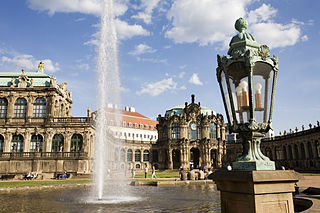
Dresden is the capital city of the German state of Saxony and its second most populous city, after Leipzig. It is the 12th most populous city of Germany, the fourth largest by area, and the third most populous city in the area of former East Germany, after Berlin and Leipzig. Dresden's urban area comprises the towns of Freital, Pirna, Radebeul, Meissen, Coswig, Radeberg and Heidenau and has around 790,000 inhabitants. The Dresden metropolitan area has approximately 1.34 million inhabitants.
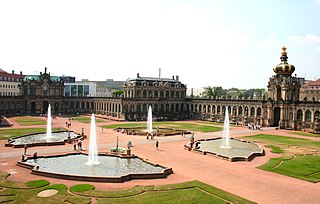
The Zwinger is a palatial complex with gardens in Dresden, Germany. Designed by architect Matthäus Daniel Pöppelmann, it is one of the most important buildings of the Baroque period in Germany. Along with the Frauenkirche, the Zwinger is the most famous architectural monument of Dresden.
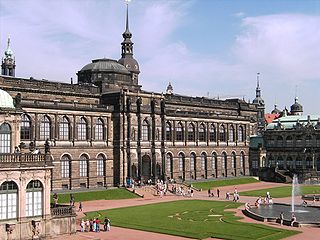
The Gemäldegalerie Alte Meister in Dresden, Germany, displays around 750 paintings from the 15th to the 18th centuries. It includes major Italian Renaissance works as well as Dutch and Flemish paintings. Outstanding works by German, French, and Spanish painters of the period are also among the gallery's attractions.

The Staatstheater am Gärtnerplatz, commonly called the Gärtnerplatztheater, is an opera house and opera company in Munich. Designed by Michael Reiffenstuel, it opened on 4 November 1865 as the city's second major theatre after the National Theatre.
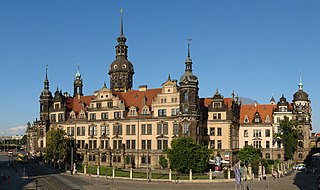
Dresden Castle or Royal Palace is one of the oldest buildings in Dresden, Germany. For almost 400 years, it was the residence of the electors (1547–1806) and kings (1806–1918) of Saxony from the Albertine House of Wettin as well as Kings of Poland (1697–1763). It is known for the different architectural styles employed, from Baroque to Neo-renaissance.
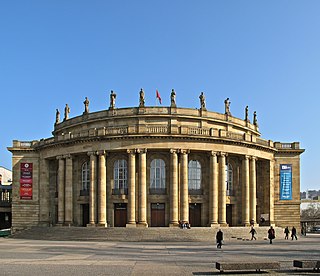
The Staatstheater Stuttgart is a theatre with three locations, Oper Stuttgart, Stuttgarter Ballett, and Schauspiel Stuttgart, in Stuttgart, Germany. The state that its name refers to is Baden-Württemberg.

Rimini Protokoll is a German theatre group founded in 2000 by Helgard Haug, Stefan Kaegi, and Daniel Wetzel. They create stage plays, interventions, scenic installations, and radio plays. Many of their works are characterized by interactivity and a playful use of technology.

Staatliche Kunstsammlungen Dresden is a cultural institution in Dresden, Germany, owned by the State of Saxony. It is one of the most renowned and oldest museum institutions in the world, originating from the collections of the Saxon electors in the 16th century.
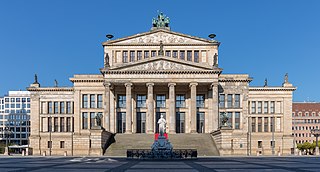
The Konzerthaus Berlin is a concert hall in Berlin, the home of the Konzerthausorchester Berlin. Situated on the Gendarmenmarkt square in the central Mitte district of the city, it was originally built as a theater. It initially operated from 1818 to 1821 under the name of the Schauspielhaus Berlin, then as the Theater am Gendarmenmarkt and Komödie. It became a concert hall after the Second World War, and its name changed to its present one in 1994.

The Staatstheater Nürnberg is a German theatre company in Nuremberg, Bavaria. The theatre is one of four Bavarian state theatres and shows operas, plays, ballets and concerts.

The Hessisches Staatstheater Wiesbaden is a German theatre located in Wiesbaden, in the German state Hesse. The company produces operas, plays, ballets, musicals and concerts on four stages. Known also as the Staatstheater Wiesbaden or Theater Wiesbaden, its orchestra is the Hessisches Staatsorchester. The building was inaugurated in 1894.

The Semper Gallery or Semper Building in Dresden, Germany, was designed by the architect Gottfried Semper and constructed from 1847 until 1854.

The Staatstheater Mainz is a theatre in Mainz, Germany, which is owned and operated by the state of Rhineland-Palatinate. Situated on the Gutenbergplatz, the complex comprises two theatres which are connected by an underground passage and also by skywalk. Performances of opera, drama and ballet are presented. Its name was Stadttheater Mainz until 1989.

The Staatstheater Darmstadt is a theatre company and building in Darmstadt, Hesse, Germany, presenting opera, ballet, plays and concerts. It is funded by the state of Hesse and the city of Darmstadt. Its history began in 1711 with a court theatre building. From 1919 it was run as Landestheater Darmstadt. The present theatre was opened in 1972 when the company was named Staatstheater.
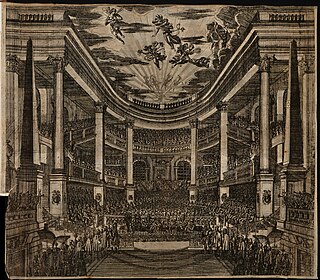
The Opernhaus am Taschenberg was a theatre in Dresden, Saxony, Germany, built from 1664 to 1667 by Wolf Caspar von Klengel. It was the first opera house of the capital of Saxony, Residenz of the Elector of Saxony. Seating up to 2000 people, it was at the time one of the largest opera houses in Europe. It was also called Klengelsches Opernhaus and Komödienhaus am Taschenberg.

Hanover Drama is a theatre company in Hanover, the state capital of Lower Saxony, Germany. The company is resident at the Hanover Playhouse situated approximately 200 metres (660 ft) east of Hanover Opera House, and the Ballyard situated approximately 530 metres (1,740 ft) west-southwest of the opera house in the old town. Collectively these venues have five stages:

The Theaterplatz in Dresden is a historic square in the city. It is located in the west of the inner old town.

The Morettische Opernhaus was the most frequently performed opera house in Dresden from the end of the 18th century, in the era of Carl Maria von Weber and until the construction of the first Königliches Hoftheater Dresden.

The Hans Otto Theatre, named after the actor Hans Otto, is a municipal theatre in Potsdam in Germany. Its headquarters and main venue is in the Großes Haus am Tiefen See in Potsdam's cultural district on Schiffbauergasse. Other regular venues are the neighbouring historic Reithalle and occasionally the Palace Theatre in the Neues Palais.
Hasko Weber is a German actor and theatre director.



















